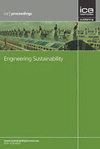采用模拟智能气凝胶隔热系统的外墙的导热性能
IF 2.5
4区 工程技术
Q3 ENGINEERING, CIVIL
Proceedings of the Institution of Civil Engineers-Engineering Sustainability
Pub Date : 2024-04-27
DOI:10.1680/jensu.23.00064
引用次数: 0
摘要
现代技术比以往任何时候都更多地采用智能设计,以应对环境变化,产生更理想的结果。在建筑和住房行业,智能设计旨在通过温度控制、能源储存和分配系统来节约能源。在此背景下,我们对建筑外墙的智能气凝胶隔热系统进行了建模和研究。气凝胶的导热系数约为 0.012 W/m-K,具有优异的隔热性能,围绕气凝胶的智能设计将为系统带来额外的能量储存和输送功能。在这项研究中,我们在一个开放的城市环境中建造了一个测试室和一个控制室,为了实现智能化,我们首先根据复合材料科学研究人员的研究,选择了具有智能特性工程潜力的气凝胶,其次考虑了在测试室中手动应用的自动化。经计算,使用智能气凝胶隔热材料的外墙导热系数为-(1.83 ± 0.06) × 10-1 W/m。负号是系统功能而非材料的属性。采用智能气凝胶隔热材料的外墙与相同的非隔热外墙相比,节能效果提高了 2.7 倍。本文章由计算机程序翻译,如有差异,请以英文原文为准。
Thermal conductivity of an external wall with simulated smart Aerogel insulation system
Modern technologies are more than ever adopting intelligent designs that respond to environmental variants to produce more desirable outcomes. In the building and housing industries, intelligent designs aim to conserve energy through temperature controls and energy storage and distribution systems. In this context, an intelligent Aerogel insulation system is modelled and studied for the exterior building walls. Aerogel with a thermal conductivity of about 0.012 W/m-K has a superior insulating property, and an intelligent design built around it would introduce additional energy storage and delivery enhancements to the system. In this study, a test room and a control room in an open urban environment were built, and the intended intelligence, first considered by choosing Aerogel that has the potential to be engineered with smart properties according to researchers in composite material science, and second was considered by automation which was applied manually to the test room. The calculated thermal conductivity of an external wall with intelligent Aerogel insulation is -(1.83 ± 0.06) × 10−1 W/m. The negative sign is an attribute of a system function rather than of a material. The external wall with intelligent Aerogel insulation, in comparison to an identical non-insulated wall, exhibited 2.7 times better energy conservation.
求助全文
通过发布文献求助,成功后即可免费获取论文全文。
去求助
来源期刊

Proceedings of the Institution of Civil Engineers-Engineering Sustainability
ENGINEERING, CIVIL-ENGINEERING, CIVIL
CiteScore
3.70
自引率
16.70%
发文量
44
审稿时长
>12 weeks
期刊介绍:
Engineering Sustainability provides a forum for sharing the latest thinking from research and practice, and increasingly is presenting the ''how to'' of engineering a resilient future. The journal features refereed papers and shorter articles relating to the pursuit and implementation of sustainability principles through engineering planning, design and application. The tensions between and integration of social, economic and environmental considerations within such schemes are of particular relevance. Methodologies for assessing sustainability, policy issues, education and corporate responsibility will also be included. The aims will be met primarily by providing papers and briefing notes (including case histories and best practice guidance) of use to decision-makers, practitioners, researchers and students.
 求助内容:
求助内容: 应助结果提醒方式:
应助结果提醒方式:


